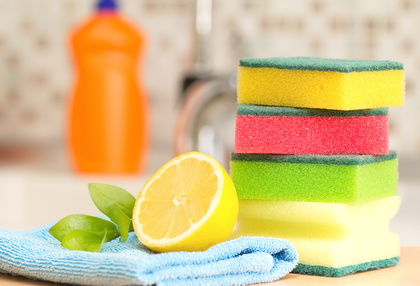 I admittedly have more intellectual curiosity about how nature works than skill or dedication to cleaning. However, here are some things I have learned over many years of trial and error and observation of what is often referred to as “dirt”.
I admittedly have more intellectual curiosity about how nature works than skill or dedication to cleaning. However, here are some things I have learned over many years of trial and error and observation of what is often referred to as “dirt”.
I praise you and don’t judge if you just bleach, vinegar, or Lysol every bit of scum, bug, or dirt you find but I’m writing about a different approach for those interested. A quick quiz:
What kills mold fungus and yeast?
What halts bacteria?
How do you remove india moths, carpet beetles, moths, ants, and stink bugs?
If you answered bleach, peroxide, and a vacuum cleaner then you don’t have to read on. You’re at least partially right and on the right track. Here are some observations for the curious:
A green spore found under a new potato chip bag on the stovetop after I returned from shopping: Added lemon:
Added lemon: See the black dot appears in center. Lemon like other acids will bring the invisible to the surface. Fungus, mold, and yeast spores have many sizes and shapes. Some are round and others look like small stones or sticks. The important thing is that they are colonies and removing one does not deter the rest. Clean perimeters and work spiraling in. Haven’t you ever tried to remove a stain or some scum only to have it appear elsewhere or spread? Just like bugs drop an micro-egg when you kill them, fungi can rejuvenate themselves quite a distance away.
See the black dot appears in center. Lemon like other acids will bring the invisible to the surface. Fungus, mold, and yeast spores have many sizes and shapes. Some are round and others look like small stones or sticks. The important thing is that they are colonies and removing one does not deter the rest. Clean perimeters and work spiraling in. Haven’t you ever tried to remove a stain or some scum only to have it appear elsewhere or spread? Just like bugs drop an micro-egg when you kill them, fungi can rejuvenate themselves quite a distance away.
There is a soap scum bug that has caused me to blame my husband for leaving a messy sink. I was cleaning the powder room basin with something called “Wipe-away” when I accidentally spilled hydrogen peroxide (that I clean toothbrushes with) on the counter. This small white bug with two tiny antenna appeared by the left wall. Of course I squashed it but I’m sure it was responsible for swirling the soap and leftover toothpaste around the sink.
Many of my customers at Walmart have complained about these tiny ants in the kitchen that are hard to kill. They are mostly buying Terro, which is a tried and true way to get rid of ants, but it doesn’t work on this species. The key to them is small black micro-dots that transform quickly to adult ants. One customer recommended an automotive upholstery cleaner that I have found to work. For the curious here is what I found:
I added water then lemon juice to a worm-like thing under the wood on the windowsill and immediately several yellow discs appeared along with a black dot such as those on the tissue and container. Two minutes later the black dot actually jumped toward me and became an ant (until I squished it). The point is these pests grow quickly and if you look carefully you can find them on pans, your hands even, and grocery items. Check you grocery bags, your hands, and especially your food, carefully.
“Dirt” is not necessarily inert. Try sprinkling baking soda on your couch and let it sit while you go to work. When you return, your couch may smell fresh, but there is “dirt” on the wood floor far away from it. If you have dogs, it’s their fault of course, right?
On the left, baking soda was sprinkled on the “dirt”. The next two pictures show what is cast off after a few minutes. A lot of people will tell you that dirt moves or spreads and they are somewhat right but it moves because it isn’t dirt. It is mold or yeast mixed with dirt and bacteria. (You know not to mix bleach and ammonia and vinegar added to baking soda will erupt like the volcano at a school science fair, right?) My suggestion: Wear gloves, add water or detergent/water combo and pick up with a disposable cloth or sponge because it won’t all transfer to the dustpan or vacuum. Throw it all out outside and forget the paltry cost of gloves, rag, or sponges. Check the corners and room perimeters for anything like little stones, sticks or anything fuzzy. These organisms, like so many, are colonies and can regenerate from a tiny part.
Other things I’ve learned – either still working on or learned the hard way:
Keep all food pantry items in sealed containers or ziplock bags including new purchases. India moths can hitchhike in coconut flour, sugar, or cereal from the most reputable places. They hide in can grooves and under soup labels that aren’t glued all the way and just one larva overlooked will be costly when you have to throw away food that must be disposed of outside – not the trash.
 Light gray, paper-thin critter that squishes to fine dust
Light gray, paper-thin critter that squishes to fine dust
Refrigerators – Use glass storage if you can and discard leftovers after two or three days. Baking soda stick-ons and regular shelf wiping help a lot. Bag partially open vegetables and other items in the freezer to keep it neat and if you think no bugs can survive the cold temperature think again. A note to smokers, put your pack of cigarettes in the freezer before smoking. Trust me, just do it.
Vacuum the car fairly often and I don’t need to say that if your dogs travel in it, clean the seats.
While clean tables, chairs, and furniture are important, UNDER them is often where bugs, spiders, and molds hide. Also the corners of cabinets and rooms often host the “mother ship” of pests and organisms.
Lemon juice has so many uses: Spray in laundry tub and dryer (Highlights any germs left behind and kills bacteria). Softens calluses. Spray on vegetables (lettuce, celery, carrots, broccoli and potatoes). Spray on your hands to make germs etc. visible.
I can’t tolerate bleach smell or inhalation but for some things I will risk feeling ill for a few hours.
If you use baits for waterbugs (roaches) remove and replace them after three months as they sometimes have a reverse effect after that time. Here in Pittsburgh, Penn State Extension will identify any bug or tick you find for free if you want.
My daughter vacuumed up a black widow spider from a dark basement corner at her California home. (Empty vacuum outside immediately) and though such spiders are rare, use caution when cleaning dark places. Even very small spiders can bite. I opened the sealed inner wrapping of a package of frozen sliders and two white spiders raced out. I would not have seen them as they were very very tiny but it was on the black stovetop.
Stink bugs are a pain. So what they’re attracted to light and laundry. The areas where they congregate (windowsills, windows) have something that they eat (I don’t want to know) and must be eliminated.
Many organisms are capable of embedding themselves in plastic, metal and unfortunately your fingertips. I am selective about what I put in my new dishwasher but when items come out with brown spots, or white splotches (plastic containers) they get a dose of isopropyl alcohol, hydrogen peroxide, lemon juice, or bleach (maybe) if it’s something I need to keep, otherwise I discard it. Time is precious and searching the internet for ways to clean a $.99 plastic container is a waste. Be sure to discard the corresponding plastic lid too or you’ll end up with 20 lids that don’t fit anything.
Again, I am not a cleaning guru and always have more cleaning tasks than I have time for. I don’t mean to give anyone the heebeegeebees or incite paranoia but I do think that understanding the nature of “dirt” and its organisms can help when cleaning.
Use your cellphone camera as a bug detector? Hold camera close to stove countertop and you can see under the top where beasties may hide. I have to wipe off my phone while I’m thinking of it.
I used my iPhone for all pictures here except the first and last which are purchased Fotolia stock photos. Take a break and think on what you have accomplished not what still needs done. Jeanie






